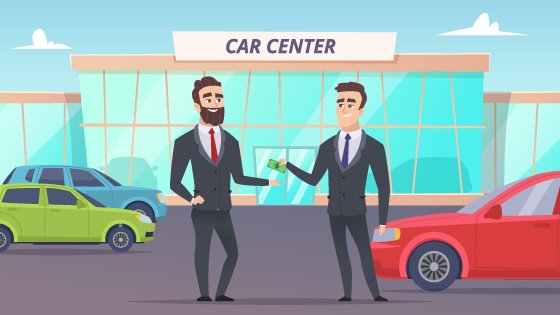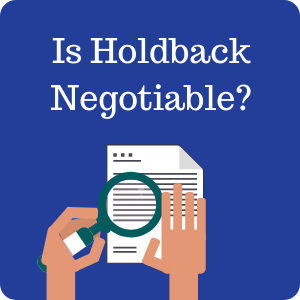What is Dealer Holdback: An In-depth Look
January 18, 2021

I am a serial entrepreneur and a consumer advocate. When I’m not helping car buyers, I love working on ventures that have a positive impact.
I run a cause marketing agency and serve on the board of Vayu Global Health where we are disrupting the medical industry and preventing the needless deaths of mothers and babies during childbirth.
 Dealer holdback is a percentage of the price of a new car, typically 2-3% of MSRP, that is returned to a dealer from the manufacturer after a car is sold. It's important to know that holdback is typically not up for negotiation and not all manufacturers even provide it to dealers.
Dealer holdback is a percentage of the price of a new car, typically 2-3% of MSRP, that is returned to a dealer from the manufacturer after a car is sold. It's important to know that holdback is typically not up for negotiation and not all manufacturers even provide it to dealers.
Holdback is money used to help dealers pay for finance charges they have accrued while keeping unsold cars on their lot. This is a "refund" of money to the dealer for what they originally paid to buy the car from the manufacturer.
Table of Contents
How Does Dealer Holdback Work?
 Although you'd assume that car dealers make a small fortune every time they sell a new car, that’s not always the case. In fact, there are a lot of costs associated with selling you that car, and that can leave the dealer with little to no profit at the end of the day.
Although you'd assume that car dealers make a small fortune every time they sell a new car, that’s not always the case. In fact, there are a lot of costs associated with selling you that car, and that can leave the dealer with little to no profit at the end of the day.
Typically, car dealers will finance their inventory through something called a Floor Plan. When they order a car from the factory, the finance company covers the invoice price, and the dealer pays a certain amount of interest for every day that the vehicle remains in inventory. Once the car sells, the dealer pays off the loan, and the car gets replaced.
As you would expect, the dealer can make more money by selling the vehicle faster (since he’s not paying as much interest). To do this, many dealers will hold one of those “invoice” sales, where a car will seemingly be sold for the dealer’s cost. But there’s a little more to it than that.
To bolster the dealer’s bottom line, manufacturers instituted something called “dealer holdback”. This is a percentage of a vehicle’s price that gets returned to the dealer several times a year (usually quarterly). When determining the invoice price, the dealer holdback is generally included in the price.
What is the Purpose of Dealer Holdback?
The purpose of the dealer holdback is to offset the interest paid by the dealer to finance his inventory. This ‘holdback’ is usually capped at 2-3% of the vehicle’s invoice price.
Since the dealer can keep more of that money if he doesn’t have to pay 2 months' worth of interest, those $1 over/under invoice sales have become quite popular. They not only allow the dealer to move their inventory faster, but their salesperson’s commission is also capped at the invoice price of the car. Leaving more of the holdback to be counted as profit.
Holdbacks also increase dealership profit because it reduces commissions paid to salesmen. The "on paper" cost of the car is increased by holdback thereby reducing the gross profit of a sale. Since salesmen are paid commissions based on gross profit for a vehicle, a lower gross profit means a lower commission.
Read about other car financing terms in this car terms glossary.
How to Calculate Dealer Holdback
The dealer holdback percentage depends on the vehicle manufacturer. For example, the 3% dealer holdback for a Buick is calculated off total MSRP, while the Lexus 2% holdback is off base MSRP. On the other hand, the Nissan 2% holdback is off the total invoice. To calculate the dealer holdback, you must know the manufacturer of the car.
Take a Ford for example. The holdback is 3% off total MSRP. Imagine that you are looking at a Ford with an MSRP of $25,700. This MSRP includes optional features and a $700 destination fee. Based on this, the invoice price is $21,000. The dealer holdback is 3% of the total MSRP (3% of $25,000), which is $750. You must subtract the $700 destination fee when calculating, as it’s not part of the total MSRP. Even if the dealer sells the car to you for the invoice price, he will make $750 on the deal from holdback.
Is Dealer Holdback Negotiable?
 Since it is basically the dealer's own money, they are often not thrilled with the idea of passing this money along to the consumer.
Since it is basically the dealer's own money, they are often not thrilled with the idea of passing this money along to the consumer.
When negotiating the price of your new car, the dealer holdback will almost never be up for discussion. This is the dealer’s fall-back profit, and many times, it will just cover the floor plan interest and the salesman’s commission.
If there actually is a dealer holdback, the salesman won’t be able to tell you the amount. Their commission is based on the “gross profit”, so the only ones to know the amount of the holdback will be the sales manager and upper management. Since the dealer holdback is paid out by the manufacturer, just let the dealer have this money.
Dealer Holdback by Manufacturer
The holdback amount varies from manufacturer to manufacturer and may vary from what’s shown below.
Here's a few examples of car dealer holdback for popular car brands:
What is dealer holdback Honda?
Answer: 2% off base MSRP
What is dealer holdback Toyota?
Answer: 2% off base MSRP
What is dealer holdback Ford?
Answer: 3% off total MSRP
What is dealer holdback Subaru?
Answer: 2% off total MSRP
Here’s a dealer holdback chart for all manufacturers:
| Car Manufacturer | Dealer Holdback | How is Holdback Calculated |
|---|---|---|
| Acura | 2% | off base MSRP |
| Audi | none | |
| BMW | none | |
| Buick | 3% | off total MSRP |
| Cadillac | 3% | off total MSRP |
| Chevrolet | 3% | off total MSRP |
| Chrysler | 3% | off total MSRP |
| Dodge | 3% | off total MSRP |
| Fiat | 3% | off total MSRP |
| Ford | 3% | off total MSRP |
| GMC | 3% | off total MSRP |
| Honda | 2% | off base MSRP |
| Hyundai | 3% | off total MSRP |
| Infiniti | 1.50% | off base MSRP |
| Jaguar | none | |
| Jeep | 3% | off total MSRP |
| Kia | 3% | off base MSRP |
| Land Rover | none | |
| Lexus | 2% | off base MSRP |
| Lincoln | none | |
| Mazda | 1% | off base MSRP |
| Mercedes Benz | 1% | off base MSRP |
| Mercury | 3% | off total MSRP |
| Mini | none | |
| Mitsubishi | 2% | off base MSRP |
| Nissan | 2% | off total invoice |
| Porsche | none | |
| Ram | 3% | off total MSRP |
| Scion | none | |
| Smart | 3% | off total MSRP |
| Subaru | 2% | off total MSRP |
| Toyota | 2% | off base MSRP |
| Volkswagen | 2% | off base MSRP |
| Volvo | 1% | off base MSRP |
Posted in Car Buying Tips, Car Finance |

